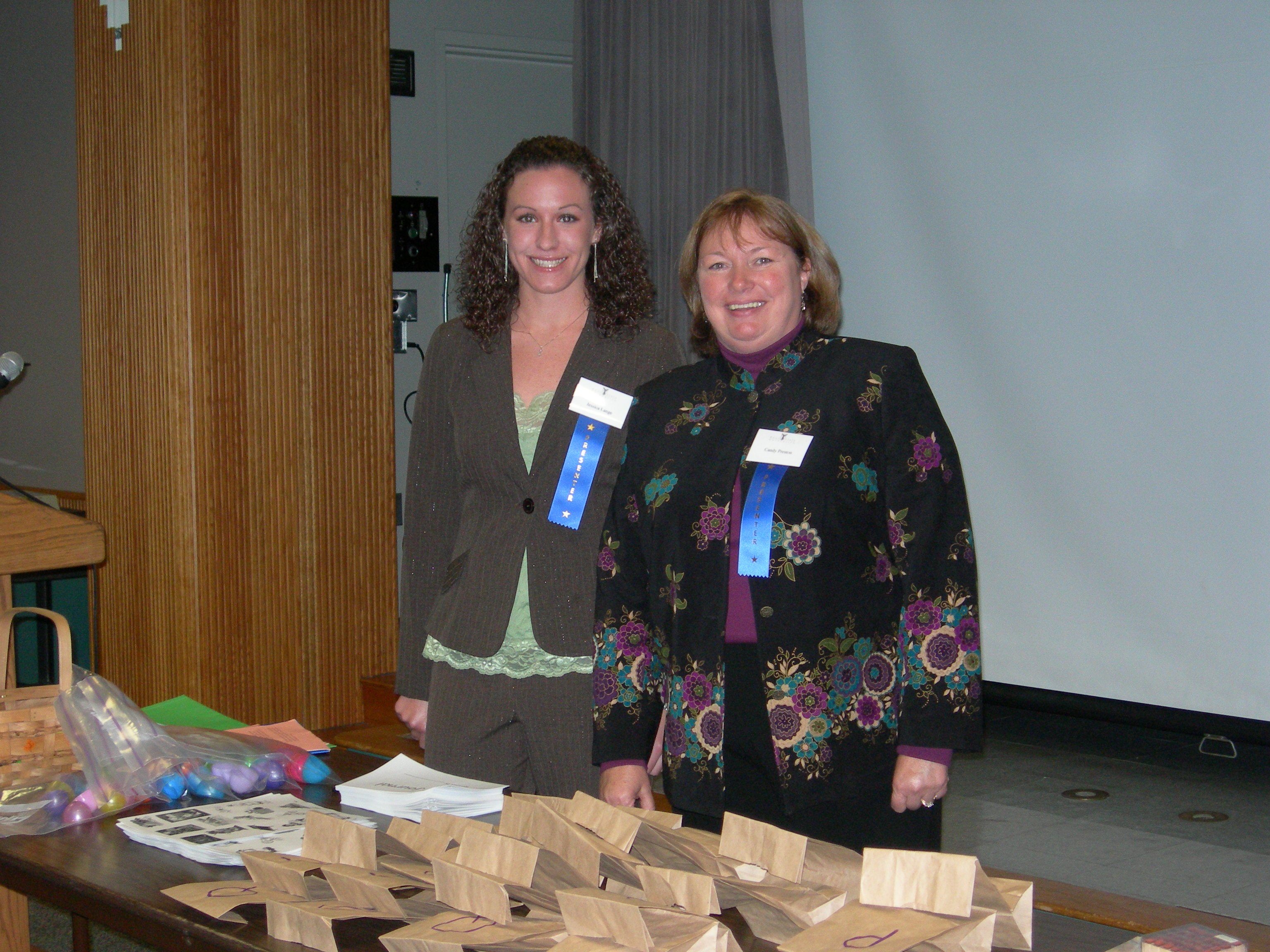
Professional Work
How wonderful it is that nobody need wait a single moment before starting to improve the world.
Anne Frank
October 22, 2005
Early Childhood Conference
Presenters: Heather Schilling, Candice Preston, Jessica Lange
Title: Encouraging Emergent Literacy: Activities to Engage Preschoolers.
Description: Through hands-on activities, learn
engaging ways to develop emergent literacy skills in preschoolers.

Jessica Lange and I preparing for our presentation.
Activities:
Alphabet War (or Love)
Purpose: To help students recognize and learn the names of the letters.
To help students learn the placement of the letters in the alphabet.
Preparation: Make a deck of cards with the letters of the alphabet. You may make both uppercase and lowercase and use them at the same time or do each one in isolation.
How to play: Two players or teams of two may play. Deal the cards evenly between the two player or teams. Each player or team turns up one of their cards. The player or team whose card is first in the alphabet gets to keep both cards. The player or team with the most cards at the end of the time allowed is the winner.
Variation: For older or advanced students, vocabulary words, spelling words, theme words, etc. may be used.
Paper Bag Guessing Game
Purpose: To help students recognize letters and their sounds.
To help students develop the skill of deduction.
Preparation: On the outside of paper lunch sacks, write one letter. Place an object in each bag that starts with that letter.
How to play: Introduce one of the bags by asking what the letter is on the outside and what sound that letter makes. Let each child feel what is inside the bag by feeling the outside of the bag only. Tell them not to tell anyone yet what they think is in the bag. After everyone has been given a chance let each child say what their guess is. Write their answers down on the board. Show them what was in the bag. Review the letter and letter sound. Talk about how that item felt in the bag.
Journal Writing
Purpose: To help students match words to pictures.
To help students develop writing skills using predictable statements.
Teacher Preparation: Create or buy blank books for the students to write on. Gather magazines, clip art pictures, stickers, glue, and scissors.
How to play: Allow students to cut pictures out of magazines or use stickers. Early learners can complete the prewritten sentences with teacher's help or the teacher acts as a scribe. Older learners can write their own sentence on the bottom of the journal page to describe the picture. When finished, read the book together.
Examples of book: I like .... I see ....
Variations: Only write the name of the picture underneath. Alphabet books and name books (with pictures of classmates, teachers, family, etc. All of these can be used with special needs children as well.
Easter Egg Matching Game
Purpose: To give students the opportunity to work on fine motor skills.
To help students match lowercase with uppercase letters.
To help students make simple words.
Preparation: You will need plastic Easter eggs that pull apart and are usually found in the spring. Using a permanent marker, on one side of the egg write an uppercase letter. On the other side of the egg write the lowercase letter to match.
How to play: Pull the eggs apart and place them in a basket. The students must find the uppercase and lowercase letters to match and put the eggs back together. Students may also spell out simple words or their names using the eggs.
Other Activities
ABC Freeze Tag
One or two children are chosen to be taggers. When a child is tagged, they must freeze and can only become unfrozen when they tell the teacher, who is circulating around, a word (or sound) that begins with the letter that is agreed to at the beginning of the game.
Magnetic Letters
On a dry erase board place 2 - 3 sets of magnetic letters. In groups of 2-3 have students "write" the words from a given list. The words should be familiar to the students, possibly other classmates' names, words from a familiar text, etc.
Rubber Stamps
Have students use rubber stamps to make words from a word wall or list on a piece of paper. These should be words familiar to the students.
Chalkboard
Let students explore printing letters on a chalkboard.
Leap Frog (best with a small number of children)
Place letters on the floor in a large area. Have students spread out and stand at their "station." Instruct children to hop to the letter A then hop back to their station. Instruct students to skip to the letter B then skip back to their station. Continue with other activities and letters. Assess if each child is going to the correct letter.
Big Book
Choose a big book with repeated phrases. Read the book to the children several times. After the book has become familiar to the children put the book in a center. Let the children "read" the book to each other.